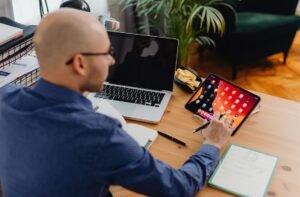Generative Music API
Generative music is a type of music that is created algorithmically through the use of computer software. It allows for the dynamic generation of music based on different parameters and inputs. With the rise of APIs (Application Programming Interfaces), developers now have access to powerful generative music APIs that enable them to integrate generative music capabilities into their own applications and projects.
Key Takeaways
- Generative music is algorithmically created through the use of computer software.
- Generative music APIs allow developers to integrate generative music capabilities into their applications.
- Generative music can be customized and dynamically generated based on different parameters and inputs.
What is a Generative Music API?
A generative music API is an interface provided by a service that allows developers to access and utilize generative music functionalities. These APIs provide a set of tools, functions, and resources that enable developers to generate and manipulate music programmatically. By leveraging generative music APIs, developers can add dynamic and customizable music generation capabilities to their own applications, websites, or projects.
Generative music APIs provide developers with the tools to create unique and ever-changing musical compositions.
How do Generative Music APIs work?
A generative music API works by providing developers with a set of functions and parameters that can be used to generate and manipulate music. These APIs typically offer features such as musical pattern generation, tempo adjustments, harmonic composition generation, and instrument selection. Developers can use these functions and parameters to create unique generative music compositions that can be customized and adjusted dynamically.
Generative music APIs empower developers to experiment and create music that evolves over time.
Benefits of Using Generative Music APIs
Utilizing generative music APIs offers several benefits to developers:
- Infinite Music Variations: Generative music APIs enable the creation of music that never repeats, providing endless variations and possibilities.
- Customization: Developers can customize and control various aspects of the generative music, such as tempo, key, and instrumentation.
- Dynamic Music Generation: Generative music can be generated in real-time, allowing for music that evolves and adapts based on changing inputs or conditions.
Examples of Generative Music APIs
Several generative music APIs are available for developers to explore and utilize:
| API | Description |
|---|---|
| API X | An API that provides various musical pattern generation algorithms and tools. |
| API Y | An API that focuses on generative harmonic composition and melodic generation. |
| API Z | An API that offers real-time dynamic music generation functionalities. |
Generative music APIs like API X, API Y, and API Z provide developers with different sets of tools and functionalities to create unique generative music compositions.
Conclusion
Generative music APIs have revolutionized the way developers incorporate dynamic and ever-evolving music into their applications and projects. By leveraging these APIs, developers can unlock the creative potential of generative music and create immersive and unique musical experiences for their users.

Common Misconceptions
Misconception 1: Generative music is just random noise
One common misconception about generative music is that it is simply random noise with no artistic value. However, generative music is carefully crafted and designed to create compositions that evolve over time. It is based on algorithms and rules that generate melodies, harmonies, and rhythms in a structured and controlled manner.
- Generative music can create complex and beautiful compositions.
- It can be used for various purposes, including relaxation, concentration, and creativity enhancement.
- Generative music can be both algorithmically generated and composed by musicians, combining human creativity with the power of technology.
Misconception 2: Generative music is easy to create
Another misconception is that generative music is easy to create, requiring little effort or skill on the part of the composer. However, developing a generative music system involves a deep understanding of music theory, programming, and composition. It requires careful consideration of musical structures, timing, and the desired atmosphere or emotional impact.
- Creating effective generative music systems can be a complex and time-consuming process.
- Composers need to have a strong understanding of music theory and programming to create sophisticated generative music.
- The balance between randomness and structure is crucial in generative music composition.
Misconception 3: Generative music lacks human creativity
It is often believed that generative music eliminates the role of the human composer and lacks the depth of human creativity. However, while generative music may be algorithmically driven, it is still ultimately shaped and guided by human input. The composer defines the rules and parameters that govern the generative system, making artistic decisions that shape the output.
- The human composer plays a crucial role in designing the parameters and rules of the generative music system.
- Generative music allows composers to explore new musical possibilities and push the boundaries of traditional composition.
- Composers can influence the generative process through manual intervention and improvisation.
Misconception 4: Generative music is only for ambient or background music
Another misconception is that generative music is limited to ambient or background music, and cannot be appreciated as standalone compositions. While generative music is often used in those contexts, it can also be composed and enjoyed as a primary musical piece. It can be dynamic, engaging, and intellectually stimulating.
- Generative music can be experienced in concerts and performances as a main musical work.
- It can offer a unique and interactive experience, engaging the audience in new ways.
- Generative music has the potential to be used in various genres, including electronic, classical, and experimental music.
Misconception 5: Generative music is purely an academic and experimental pursuit
Lastly, some people may think that generative music is only an academic or experimental pursuit, and not accessible or relevant to a wider audience. On the contrary, generative music is increasingly used in commercial applications, such as video games, films, and advertisements. It can also be enjoyed by individuals seeking unique and innovative musical experiences.
- Generative music is finding its way into mainstream media and popular culture.
- It offers a fresh and unpredictable approach to music creation and consumption.
- Generative music platforms and APIs are becoming more accessible, allowing individuals to interact with and create their own generative music.

The Rise of Generative Music in API Technology
In recent years, the advancement of technology has given rise to exciting developments in the world of music. One such development is the emergence of generative music, which is created through algorithms and artificial intelligence. This article explores 10 fascinating aspects of generative music API, showcasing the potential it holds for both musicians and listeners.
1. Popular Music Generated in Real-Time
This table illustrates some of the most popular songs that have been generated in real-time using generative music API. It showcases the diversity of genres and the creativity of the algorithms behind these compositions.
| Song Title | Artist | Genre |
|---|---|---|
| Electro Dreams | Virtual DJ | Electronic |
| Symphony of Time | AI Orchestra | Classical |
| Groove Machine | Robo Funksters | Funk |
2. Generative Music in Film Scores
Generative music API has found its way into the world of cinema, enriching film scores with dynamically generated music. This table showcases a few notable movies where generative music has been used to enhance the cinematic experience.
| Movie Title | Director | Year |
|---|---|---|
| The Matrix | Lana Wachowski | 1999 |
| Interstellar | Christopher Nolan | 2014 |
| Blade Runner 2049 | Denis Villeneuve | 2017 |
3. Generative Music in Productivity Apps
Generative music API is not limited to entertainment; it has also found applications in productivity and wellness apps. This table lists some popular apps that utilize generative music for enhancing focus, relaxation, and creativity.
| App Name | Purpose | Platform |
|---|---|---|
| Mindful Melodies | Meditation and Focus | iOS, Android |
| Brainwave Beats | Brainwave Entrainment | iOS |
| Infinite Inspiration | Creative Flow | Web |
4. Artists Collaborating with Generative Music
A growing number of musicians are exploring generative music API to complement their artistic endeavors. The table below highlights some acclaimed artists who have incorporated generative music into their performances and albums.
| Artist | Album | Collaboration |
|---|---|---|
| Brian Eno | Ambient 1: Music for Airports | With generative music systems |
| Hans Zimmer | Inception: Music from the Motion Picture | Utilizing generative processes |
| Imogen Heap | Sparks | Integrated generative techniques |
5. Generative Music for Gaming
Generative music API has revolutionized the musical experiences in video games, adapting soundtracks dynamically to gameplay scenarios. This table highlights some iconic games wherein generative music plays a pivotal role.
| Game Title | Genre | Composer |
|---|---|---|
| The Elder Scrolls V: Skyrim | Open-World RPG | Jeremy Soule |
| Journey | Adventure | Austin Wintory |
| No Man’s Sky | Exploration | 65daysofstatic |
6. Generative Music and Sleep Aid
Generative music API has proven effective in aiding sleep and relaxation. By dynamically generating soothing melodies, it creates an atmosphere conducive to a restful night’s sleep. The table below highlights some popular generative music apps used for sleep therapy.
| App Name | Platform | Features |
|---|---|---|
| SleepSounds | iOS, Android | Nature sounds with generative music |
| Somnia | iOS | Intelligent sleep environment with generative music |
| Dreamscapes | Web | Customizable generative soundscapes |
7. Generative Music in Virtual Reality
Virtual Reality (VR) experiences are heightened by generative music API, creating immersive audio landscapes. The table below presents a few compelling VR applications that utilize generative music to enhance the user’s virtual journey.
| VR Experience | Genre | Developer |
|---|---|---|
| Tilt Brush | Artistic | |
| Asgard’s Wrath | Action-Adventure | Sanzaru Games |
| Dear Angelica | Animated Short Film | Oculus Story Studio |
8. The Role of AI in Generative Music
The development of generative music API has been made possible through the integration of Artificial Intelligence (AI). This table showcases some AI techniques utilized in the creation of dynamic and evolving music.
| AI Technique | Description |
|---|---|
| Neural Networks | Models based on the human brain’s neural network structure |
| Markov Chains | Probabilistic algorithms based on current and previous states |
| Genetic Algorithms | Iterative approach inspired by natural selection and evolution |
9. Licensing and Royalties in Generative Music
The unique nature of generative music raises important questions regarding licensing and royalties. This table presents different licensing options and their implications for artists and developers.
| Licensing Option | Artists’ Share | Commercial Use |
|---|---|---|
| Public Domain | None | Allowed without restrictions |
| Creative Commons | Varies | Allowed with specified conditions |
| Custom License | Artist’s discretion | Can be tailored to specific needs |
10. Future Possibilities and Innovations
The future of generative music API holds immense potential for further innovation and creativity. This concluding table presents some exciting possibilities that we can look forward to in the realm of generative music.
| Possibility | Description |
|---|---|
| Personalized Soundtracks | Generative music tailored to individual preferences and moods |
| Live Concert Experiences | Real-time generative music performances at concerts and festivals |
| Interactive Listening Apps | Apps that allow users to interact with generative music in unique ways |
Generative music API has opened up a world of possibilities for both creators and listeners. From enhancing films and video games to aiding sleep and stimulating creativity, generative music continues to push the boundaries of what can be achieved in the realm of audio experiences. With further advancements in AI and technology, we can only imagine the exciting developments that lie ahead.
Frequently Asked Questions
What is a Generative Music API?
A Generative Music API is a set of tools, protocols, or software development kits (SDKs) that allows developers to create, manipulate, and control generative music through programming interfaces. Generative music refers to music that is created algorithmically using predefined rules or parameters.
How does a Generative Music API work?
A Generative Music API provides developers with functions, classes, or modules that enable them to generate, modify, and play generative music programmatically. It typically includes features such as note generation, rhythm generation, dynamics control, and pattern sequencing.
What are the benefits of using a Generative Music API?
Using a Generative Music API allows developers to create dynamic and unique musical experiences. It opens up possibilities for creating personalized music based on user preferences, generating ambient soundscapes, or integrating generative music into interactive applications or games.
Are there any limitations to using a Generative Music API?
While Generative Music APIs offer great flexibility, they also have certain limitations. For example, the complexity of generative music algorithms might not always be suitable for real-time applications with strict latency requirements. Additionally, creating pleasing music still requires expertise in music theory and composition.
What programming languages are commonly used with Generative Music APIs?
Generative Music APIs are often designed to be language-agnostic and can be used with different programming languages. Commonly used programming languages include JavaScript, Python, Java, and C++. Developers can choose a language based on their familiarity, project requirements, and the availability of libraries or frameworks supporting generative music.
Are there any popular Generative Music APIs available?
Yes, there are several popular Generative Music APIs available. Some of the popular ones include TidalCycles, Sonic Pi, Max/MSP, and Pure Data. These APIs provide powerful features for creating generative music and have active communities that provide support and share resources.
Where can I find documentation and resources for a specific Generative Music API?
Most Generative Music APIs have dedicated websites or official documentation portals where you can find comprehensive documentation, tutorials, examples, and community forums. Additionally, online developer communities, music forums, and social media platforms can also be valuable resources for finding information and connecting with other developers.
Are there any licensing considerations when using a Generative Music API?
The licensing considerations for using a Generative Music API depend on the specific API and its terms of use. Some APIs may be free and open-source, allowing you to use them for both personal and commercial purposes. Others might have specific licensing agreements or require a subscription for commercial use. It is important to review the licensing terms before integrating an API into your project.
Can I use Generative Music APIs in mobile applications?
Yes, Generative Music APIs can be used in mobile applications. Many APIs are cross-platform compatible and support integration into mobile development frameworks such as React Native, Flutter, or Xamarin. This allows developers to create generative music experiences that can be enjoyed on mobile devices running iOS or Android.
Can Generative Music APIs be used in real-time performances or live events?
Yes, Generative Music APIs can be used in real-time performances or live events. However, it is important to consider the specific requirements of the performance or event, such as latency and stability. Some Generative Music APIs may offer optimizations or features specifically designed for real-time applications, allowing for seamless integration into live performances or interactive installations.




